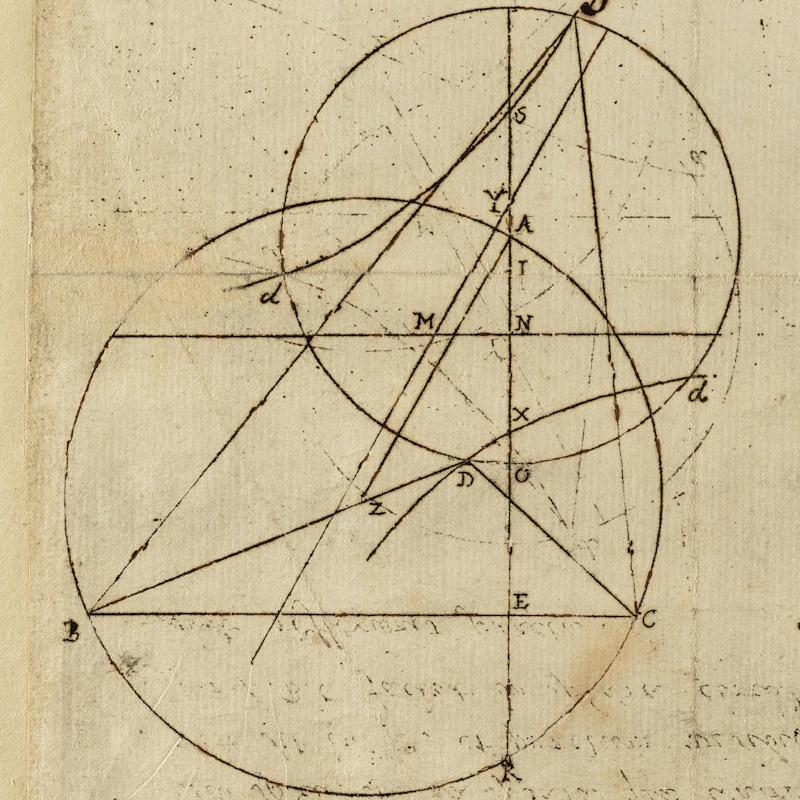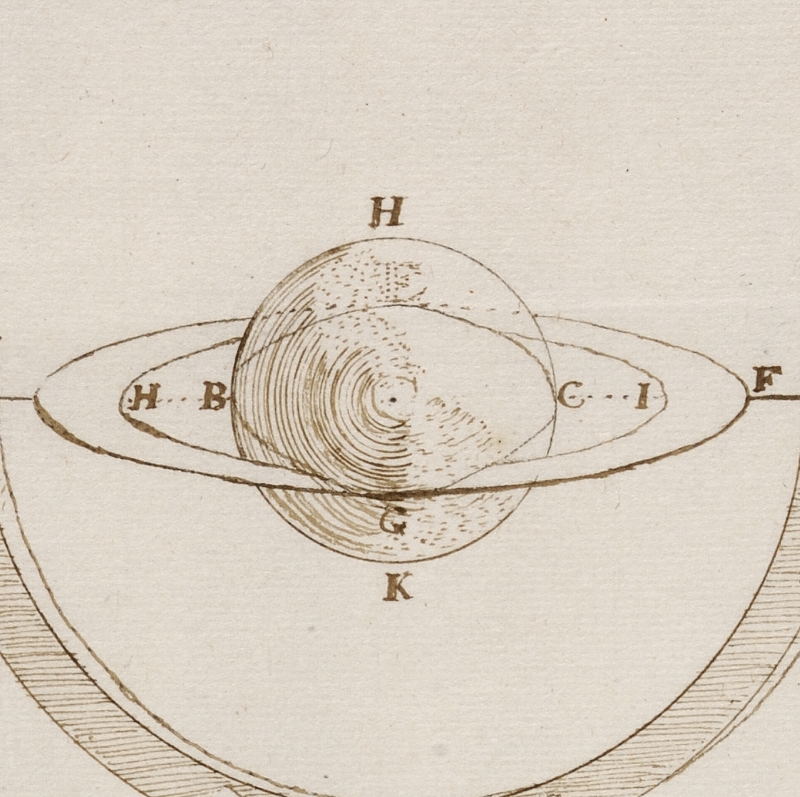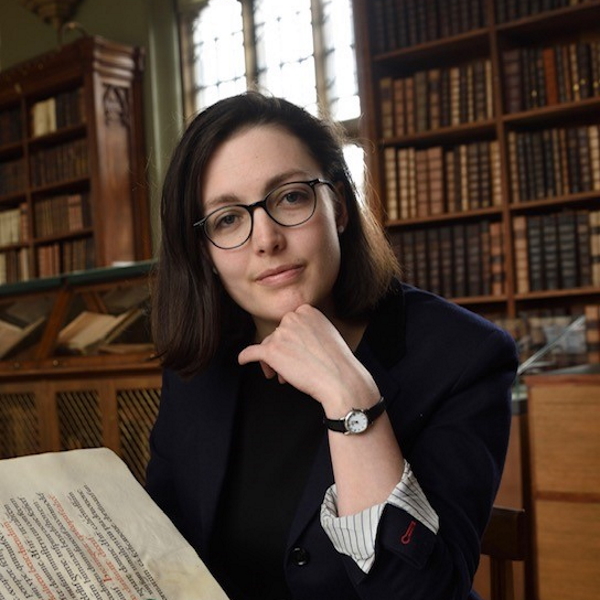Centuries before digital cameras, how did early Fellows of the Royal Society approach the tricky problem of reproducing text and images? Katherine Marshall investigates.

Our library readers are allowed to use their mobile phones to photograph documents in our reading room for their personal research. As I write this, I’m keeping an eye on a couple of readers snapping away – it’s all very routine. But centuries before digital cameras, how did early Fellows of the Royal Society approach the tricky problem of reproducing text and images?
On 26 June 1669, Christiaan Huygens wrote from Paris to Royal Society Secretary Henry Oldenburg, setting out his algebraic solution to the geometrical optics puzzle known as Alhazen’s problem (CLP/1/13). Oldenburg went on to publish an excerpt from the letter in the Philosophical Transactions in 1673, but Huygens had another reason for sending his paper: he wanted to demonstrate his new method of printing.
 Alhazen’s problem by Christian Huygens, 1669 (RS.15124)
Alhazen’s problem by Christian Huygens, 1669 (RS.15124)
Huygens had first mentioned his ‘Invention of a new way of printing’ in a letter a month earlier. The improvement of methods for copying illustrations and text was an important pursuit for the early Fellows of the Royal Society, both for the distribution of new ideas and for record-keeping. Huygens described his method as ‘cheap, and [it] can quickly both engrave plates and print’, and believed the ‘Fellows will not find much difficulty in guessing how it is done’ (EL/H1/63).
Indeed, Oldenburg’s response to the earlier letter from Huygens (EL/O1/117) indicated that both Sir William Petty and Christopher Wren were working on related techniques. Noting the similarity of Wren’s research, Oldenburg commented flatteringly to Huygens that ‘since you two have the same turn of mind you sometimes hit upon the same truly ingenious discovery.’ Oldenburg, however, was reluctant to release the details at this point, and dissuaded Huygens from revealing his method until the London-based pair had established their own.
The text and geometric figures in the letter on Alhazen’s problem allowed Wren to correctly guess Huygens’s method. This was relayed back to Huygens by Oldenburg in a letter written on 5 July 1669 (EL/O2/2):
‘taking a brass plate as thin as paper you cover it with a varnish suitable for engraving and have the design drawn on that (taking care not to close up the letters) with such strong nitric acid as quite to pierce the brass. When this is done you turn the plate, putting it on another which is thicker and entirely coated with printer’s ink; and then you pass it through a rolling press in the usual way.’
 Letter from Henry Oldenburg to Christiaan Huygens, 5 July 1669 (EL/O2/2)
Letter from Henry Oldenburg to Christiaan Huygens, 5 July 1669 (EL/O2/2)
This technique allowed for the positive transfer of text and graphics, which would have to be created in reverse for traditional engraving. It meant that a skilled printer would not be necessary, reducing the time and cost involved in creating multiple copies. It was not without its issues, however: the use of a second plate for the ink transfer meant that the two stuck together and damaged the delicate stencil when re-inking. Furthermore, if you look again at the ‘Alhazen’s problem’ paper by Huygens, you can see that the capital ‘D’ in the opening line has lost its middle, a problem caused when the acid bit through the entire plate and resulted in filled characters on the final print – hence the warning about ‘taking care not to close up the letters’.
Robert Hooke, the Royal Society’s curator of experiments, had also been tasked with investigating the new copying methods, and completed his trials towards the end of the year. He presented the results at a weekly meeting of the Society on 16 December 1669, with the Journal Book recording that he ‘exhibited another specimen of Dr. Wren’s new and compendious way of printing’, notably without mention of Huygens.
Sadly I’ve not been able to locate these examples by Hooke, but a list of his experiments and inventions (CLP/20/54) shows that he worked on no less than five new types of reproduction technique. These included a ‘new way of etching’, ‘new proposal about printing pictures’, ‘new way of printing. Sr. W Pettys’, ‘Double writing, Sr. W Petty, treble, quadruple, 5tuple, multiple writing a new way’ and ‘Zulichems way of writing through hobbihorse brasse – or stensilling.’ Christiaan Huygens’s father Constantijn was Lord of Zuilichem, so this last item likely refers to Christiaan’s new method of printing.
 List of experiments, inventions and instruments by Robert Hooke (CLP/20/54)
List of experiments, inventions and instruments by Robert Hooke (CLP/20/54)
Efforts to perfect a reproduction method were doubtless driven by the potential to make money from any resulting technology. Double-writing devices, or pantographs, were another line of investigation: Petty published his Declaration concerning the newly invented art of double writing in 1648, although it didn’t contain any details of his technique, just a claim over its priority with a 14-year patent. Wren was working on a ‘diplographical instrument’ around the same time, saying in a 1653 letter (number 104 in Parentalia, MS/249) that he was content to have shown his ideas to an ‘ingenious few’ rather than publishing them.
 Pantographice by Christophorus Scheiner, 1631 (Tracts LXX/1)
Pantographice by Christophorus Scheiner, 1631 (Tracts LXX/1)
The original pantograph or double writing machine had in fact been invented by Christoph Scheiner at the beginning of the seventeenth century, and published in his Pantographice in 1631. As well as Wren and Petty, several other copycats experimented with similar designs, including this paper submitted to the Royal Society by an unknown author (CLP/17/16) which shows a machine to make seven copies in one, clearly based on the mechanics of Scheiner’s technique:
 ‘A machine to make seven copies in one go’ (RS.15212)
‘A machine to make seven copies in one go’ (RS.15212)
As I’m responsible for the digitisation and reproduction of historical material, it’s interesting to reflect on the labours of these early Fellows in trying to find a new method of copying. We now welcome the use of smart phones in our reading room, but for readers unable to visit we also offer a digital copying service for remote access to our collections.







